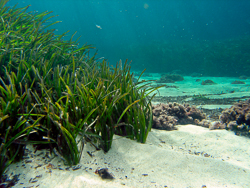ABSTRACT
It is widely accepted that light availability sets the lower limit of seagrass bathymetric distribution, while the upper limit depends on the level of disturbance by currents and waves. The establishment of light requirements for seagrass growth has been a major focus of research in marine ecology, and different quantitative models provide predictions for seagrass lower depth limits.
In contrast, the influence of energy levels on the establishment, growth, and maintenance of seagrasses has received less attention, and to date there are no quantitative models predicting the evolution of seagrasses as a function of hydrodynamics at a large scale level. Hence, it is not possible to predict either the upper depth limit of the distribution of seagrasses or the effects that different energy regimes will have on these limits.
The aim of this work is to provide a comprehensible methodology for obtaining quantitative knowledge and predictive capacity for estimating the upper depth limit of seagrasses as a response to wave energy dissipated on the seafloor. The methodology has been applied using wave data from 1958 to 2001 in order to obtain the mean wave climate in deep water seaward from an open sandy beach in the Balearic Islands, western Mediterranean Sea where the seagrass Posidonia oceanica forms an extensive meadow.
Mean wave conditions were propagated to the shore using a two-dimensional parabolic model over the detailed bathymetry. The resulting hydrodynamics were correlated with bottom type and the distribution of P. oceanica. Results showed a predicted near-bottom orbital velocity of between 38 and 42 cm s-1 as a determinant of the upper depth limit of P. oceanica.
This work shows the importance of interdisciplinary effort in ecological modeling and, in particular, the need for hydrodynamical studies to elucidate the distribution of seagrasses in shallow depths. Moreover, the use of predictive models would permit evaluation of the effects of coastal activities (construction of ports, artificial reefs, beach nutrient input, dredging) on benthic ecosystems.











